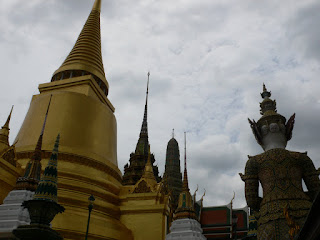


Khao San Road.
A backpackers’ haven. This road is notorious in Bangkok for being a transit point for backpackers traveling in and around Thailand. Situated about 30 kilometers away from Mo Chit bus station, it was a relatively convenient place to check in for my few day stay. The place was more or less what I had imagined—full of dreadlocked hippies and tattooed 20-somethings, Khao San is a dream come true for many wear travelers. For me, it was a chance to unwind, let loose, and indulge in endless people watching. There are several noteworthy bookstores in the area, as well as loads of cheap eats.

Keepin’ it fresh.
For as long as I’m living on this continent, I will continue to give praise to the amazing selection of fresh fruit available here. From the spiky dragonfruits and their sexy shade of pink, to the mangoes so perfect you think they came from Eden itself…the fruit stalls burst with color, texture, and an unbeatable fresh taste.

Ladies Night Out
Going to Bangkok felt like my first time really traveling alone. It was Friday night and the town was hopping. I felt eager to go out and enjoy a different side of the town as nighttime fell, so I ventured off to the first logical place I could think of to do so: the bar. It wasn’t long after I ordered a beer that I meet these girls, Katie and Hannah, both seniors at Manchester University in the UK. We hit it off, and proceeded to experience our Friday night in Khao San as it was meant to be—namely, this included unlimited Song Saem buckets and spring rolls.

Ferry… Bring me to shore!
This was one of the more exciting parts of my trip to Bangkok. On my last day, I took the ferry eastward to check out some of the most famous tourist attractions in the city. For 10 baht (35 cents), this is actually a really good deal and a logical means for transportation. First stop: the Grand Palace!

The following pictures were all taken at the Grand Palace, a complex of several historically significant buildings and temples. The palace was originally built in 1782 for King Rama I. From the 18th century on, it served as the official residency for all of Thailand’s kings. The complex sees thousands of tourists a day, and really is an impressive sight. It’s home to the Emerald Buddha (held inside Wat Phra Kaew) and contains several intricately carved golden towers. It felt really strange for me to be there by myself- nearly everyone seemed to be either on a tour group or with family. As a result, there are several goofy pictures of me standing and posing by myself, taken by one sympathetic, sunburned tourist or another.










Reclining Buddha, or as I prefer to call it, the Lazy Buddha.
My second sightseeing stop involved paying a visit to the infamous Reclining Buddha, house in the Wat Pho temple. The gold plated Buddha is an impressive 46 meters long and 15 meters high. It’s pretty interesting to walk around the entire Buddha, although securing a good viewing point is a challenge. The rest of the temple complex is almost equally noteworthy, having been constructed over 200 years ago and containing more than 1,000 Buddha images in total.

















